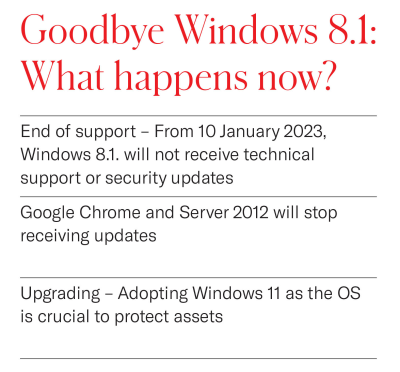Microsoft announced that Windows 8.1 will reach end of life on 10 January 2023. The operating system (OS) Windows 8.1 came before Windows 10 and it was never quite as popular as its predecessors (Windows 7, Vista, XP) nor its successors.
It has been estimated that Windows 8.1 currently holds only 2.5% of the total Windows OS worldwide market share – even less than Windows 7 at 11%. Although the end of Windows 8.1 will not affect a majority of users, and PCs operating on this version will still be usable to some extent, it is important to be aware of the changes affecting the platform. This article illustrates the implications of end of support and what can be done to upgrade.

What does end of support mean?
Each Microsoft product has a clearly stated lifecycle. The end of support marks the end of this lifecycle. This means that computers running on Windows 8.1 will no longer receive updates nor technical support.
In other words, Microsoft will not be able to resolve any issues with the system. Crucially, the platform will no longer receive essential updates that ensure stability, including security updates and bug fixes.
As a result, if your organisation is currently relying on assets with Windows 8.1 as the OS, there is a risk of significant vulnerability to cyberattacks.
Windows 8.1 and Google Chrome
From January 10th, Google Chrome will also cease to provide updates to browsers installed on Windows 8.1 systems. Chrome 109 will be the last version to be supported on Windows 7 and Windows 8/8.1, with the next version scheduled to launch in February 2023.
Older versions of the browser will continue to work on these operating systems, but new features and security updates will not be available. This is also true for any server that operates as a Terminal Server (TS) and Remote Desktop Server (RDS) that has an operating system of server 2012 where the TS or RDS has a Windows 8.1 user interface.
Windows 8.1 and Server 2012
Server 2012 is an old version of Windows Server. From October 2023, it will move out of extended support and will not receive any technical support, software or security updates.
It is recommended that users upgrade to a more updated operating system with Server 2019. In some cases, Server 2022 might also be an option. While assets running on Server 2012 will continue to function, they should be viewed as an operational risk.
Unlike Windows 8.1 on a single asset, Server 2012 upgrades are more complex due to the activities that it controls. The ROCK Solutions Design team can review and explain any potential risks associated with the upgrade, providing assistance throughout the process.
This work takes time to complete and normally involves vendors and suppliers. Planning costs and resources early is key as the process spans over several months. It is also an opportunity to review your overall technology roadmap and consider options such as moving to a cloud solution, which can be discussed with your Account Manager.

“As Windows 8.1 reaches end of support, many organisations will have to upgrade their existing IT infrastructure. At ROCK, we have a team of experts to support our clients through this process. Updating operating systems should always be the default position as opposed to waiting for an asset to move out of support. This generates cost savings in the long run and protects company data.”
Simon Matthews, Service Delivery Manager at ROCK
Alternatives to Windows 8.1
There are two main options for upgrading your OS. The recommended option is to upgrade the entire infrastructure to run on Windows 11. This way, your organisation will benefit from the safest security settings as well as more powerful machines. While changing machines is easy, if you have a machine running your line of business software, we recommend speaking to your Account Manager.
Alternatively, users can choose to keep the same computers and upgrade the OS to Windows 10. However, this is not recommended as Windows 10 will only be supported until October 2025, and keeping an outdated infrastructure will likely cause cyber security and data protection issues. Moreover, older hardware might not be covered by a warranty, so changing machines is preferred.
Conclusion
Windows 8.1. has been the least popular operating system released so far. Microsoft faced criticism for the mobile-first user interface (UI) design that characterised the first Windows 8 release in 2012. Windows 8.1 came in to solve some of these issues, presenting a desktop-like UI design, but it still had many limitations.
As Windows 8.1 comes to its end of life, organisations must make it a priority to upgrade their IT infrastructure. By harnessing the latest technologies and possibilities offered by Windows 11, such as cloud solutions and enhanced cyber security, business leaders can increase operational efficiency and cut costs.
References
- Google Chrome Community (2022) Sunsetting support for Windows 7/8/8.1 in early 2023. Google Chrome Help 24 October 2022. [Accessed: 5 January 2023]
- Microsoft (2022) SQL Server 2012 and Windows Server 2012/2012 R2 end of support. Microsoft Learn 30 June 2022. [Accessed: 5 January 2023]
- Microsoft Support (2023) Windows 8.1 support will end on January 10, 2023. [Accessed: 5 January 2023]
- Statcounter (2022) Desktop Windows version market share worldwide December 2021 – December 2022. [Accessed: 5 January 2023]